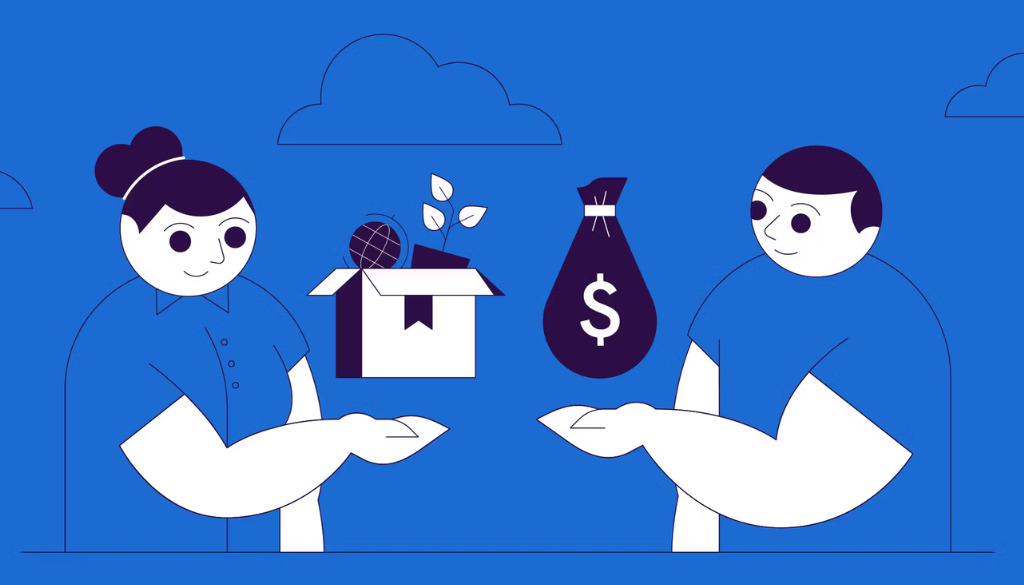Do you want to start an online business but have no products, no large capital, and don’t want to handle production yourself? The Reseller model is the perfect choice for you. Without having to create products on your own, a reseller earns profits by selling products from suppliers and keeping the price difference or commission. This model is booming in the Print on Demand (POD) industry, where all you need to focus on is marketing, while the printing facilities handle the rest. So, what is a reseller? Should you start now? And how can you become a successful reseller in the POD market? This article will guide you through everything from A to Z.
What Is a Reseller?

A reseller is an individual or business that purchases products or services from a supplier and sells them to end customers for a profit margin.
Unlike manufacturers or original product creators, resellers don’t need to develop products themselves. Instead, they focus on distribution, marketing, and customer service. This model is popular across various industries, from technology, fashion, and cosmetics to software services, hosting, and especially Print on Demand (POD).
In the POD industry, resellers can partner with reputable printing facilities such as FlashShip, select products from an existing catalog (t-shirts, hoodies, tote bags, etc.), add their own designs, and list them on sales platforms like Etsy, Shopify, or Amazon. Once an order is placed, the supplier handles all printing and shipping. The reseller’s main responsibilities are selling and customer care.
Distinguishing Resellers from Other Models
Many people often confuse Resellers with Dropshipping and Affiliate Marketing. While they share certain similarities, these are three entirely different business models.
|
Criteria |
Reseller (Traditional) |
Dropshipping |
Affiliate Marketing |
|
Inventory Storage |
May or may not store products. Often purchases and stocks inventory to control supply and pricing. |
No. Never owns or stores inventory. |
No. Only promotes the product. |
|
Sales Process |
Manages everything independently: from marketing and sales to packaging and shipping. |
Handles marketing and sales. When an order is placed, forwards the customer information to the supplier for fulfillment. |
Simply directs traffic via a link to the seller’s website. |
|
Transactions |
Receives payment directly from customers. |
Receives payment directly from customers, then pays the supplier for the products. |
Does not participate in the transaction. Earns a commission from the seller. |
|
Profit |
The difference between the selling price and purchase price. |
The difference between the selling price and the amount paid to the supplier. |
Commission (%) per successful sale. |
|
Inventory Risk |
High. Unsold products lead to excess stock and tied-up capital. |
None. No inventory risk. |
None. No inventory risk. |
Popular Types of Resellers Today
Nowadays, the reseller model is no longer limited to the simple buy-and-sell approach. It has evolved into diverse, flexible forms tailored to specific industries. Below are the four most common types of resellers, particularly suitable for those running or looking to start a Print on Demand business.

1. Physical Product Reseller
This is the traditional and most common reseller model, especially in industries like fashion, cosmetics, accessories, and POD. In this model, you resell tangible products from suppliers, which can be ready-made items or customized products based on your own designs.
In the POD field, this model is extremely flexible:
- Reselling ready-made products: You choose products from a print provider without making any design changes. Your role is to promote and sell the products, earning a profit margin or commission based on your agreement with the printing facility.
- Selling personalized products: You create your own designs for products like t-shirts, mugs, or tote bags, and list them via POD platforms. When an order is placed, the print provider handles production and ships directly to the customer. In this case, you are both a reseller and a designer—a major advantage that helps boost your personal brand value.
Combining design skills with the reseller model helps you stand out in highly competitive markets, especially in major POD markets such as the U.S., Canada, the U.K., and Australia.
2. Digital Service Reseller
Unlike physical products, digital service reselling involves selling digital-based offerings such as:
- Software packages (SaaS)
- Hosting and domain names
- Website or chatbot design services
- Online courses and learning accounts
This model has been growing rapidly thanks to its low costs, no need for warehousing or shipping. Many leading SaaS providers like Canva, Semrush, and online education platforms offer reseller or distribution partner programs, giving sellers the opportunity to earn commissions by promoting their services.
3. Affiliate Reseller
This is a reseller model in the form of affiliate marketing, where you don’t store inventory or operate a sales system. Instead, you create content, share affiliate links, and earn a commission when customers make a purchase through your link.
Affiliate reselling is ideal for content creators, influencers, bloggers, or anyone with an existing customer base. You can even combine affiliate marketing with POD, for example, promoting products from a POD platform and earning commissions for each generated order.
4. White Label Reseller
A White Label Reseller sells a supplier’s products but rebrands them under their own name, adding their own logo or packaging. This is a more advanced stage in the reseller journey, helping you clearly establish your personal or business brand.
White labeling is especially popular in industries like cosmetics, supplements, and fashion. In POD, providers such as FlashPOD offer custom branding services, allowing you to add logos, labels, thank-you cards, and more, creating a professional unboxing experience just like an independent brand.
White labeling not only increases brand recognition but also allows you to sell at higher price points thanks to the uniqueness and trust associated with your brand.
Pros and Cons of the Reseller Model

Like any business model, reselling has two sides. Understanding them will help you make the right decision.
1. Advantages
- Low startup capital: Compared to building a factory or purchasing machinery for production, the initial cost of becoming a reseller is much lower. You may only need enough capital to buy a small batch of products, or none at all if you work with Dropshipping vs. POD.
- Lower risk than manufacturing: You don’t have to worry about production processes, technical errors, or managing labor. Your main risk is inventory management.
- Flexibility and freedom: You can work from anywhere and freely decide what products to sell, where to sell them, and when.
- Easy to start: The entry barrier is low. In theory, anyone with a bit of business acumen and access to a good supplier can become a reseller.
- Product diversity: You can easily test and sell different types of products without being tied to a fixed production line.
2. Disadvantages
- Fierce competition: Because it’s easy to start, many people do it. You’ll face intense competition in terms of pricing and sourcing.
- Potentially low profit margins: As a middleman, you have to share profits with the supplier. To get better wholesale prices, you often need to purchase in large quantities.
- Complete dependence on suppliers: This can be a critical drawback. If a supplier runs out of stock, raises prices, reduces product quality, or delays shipping, your business will be directly affected and you’ll have little control over it.
- Brand-building challenges: When selling someone else’s products, it’s difficult for customers to remember your brand. They often only recall the original brand (e.g., Nike, Apple). This is an area where POD sellers can overcome the issue by offering exclusive designs.
- Inventory management issues: For resellers who stock products, miscalculating market demand can lead to excess inventory, tied-up capital, and even selling at a loss to recover funds.
What You Need to Succeed as a Reseller
Becoming a successful reseller in the POD industry isn’t just about listing ready-made products for sale. It’s a process that requires a clear strategy, thorough preparation, and the ability to adapt quickly to market changes. Below are five essential factors you need to equip yourself with if you want to excel as a professional POD reseller.

Choose the Right Niche
Not every product sells easily, especially in the highly competitive POD market. Selecting the right niche is crucial to help you save on advertising costs, create a unique brand identity, and boost conversion rates. Prioritize niches with high demand but low saturation, such as family-themed printed t-shirts, profession-based designs (nurses, teachers, drivers, etc.), or products for special occasions like Independence Day, Christmas, Halloween, or Father’s/Mother’s Day.
Understand Your Target Customers
A successful reseller always starts with in-depth customer research. You need to answer these key questions: Who are your customers? Where do they live? What are their shopping habits? Why do they buy your products, fashion, gifts, events? The more you understand them, the easier it is to create compelling content, choose the right designs, adjust pricing, and tailor your marketing strategies for better results.
Choose a Reliable Supplier
In the POD reseller model, your supplier acts as your “back office” support. A trusted print provider ensures consistent product quality, on-time delivery, and fewer returns, helping you maintain five-star ratings and increase customer loyalty. FlashPOD is a reliable choice for POD sellers, offering U.S.-based printing, fast fulfillment starting from just one day, strict quality control, custom branding options, and automated order syncing.
Invest in Design and Visuals
Even if you’re not producing the products yourself, you are responsible for how they are presented, and presentation directly impacts purchasing decisions. Invest in creative designs, professional mockups, attention-grabbing titles, and SEO-optimized product descriptions. Tools like Canva, Adobe Express, and Placeit are excellent for creating attractive, consistent visuals and scaling multiple design variations with ease.
Market Effectively
Without an effective marketing strategy, even the most stunning designs will struggle to reach customers. Depending on your niche and product type, you can leverage channels such as Etsy SEO, Facebook or TikTok ads, Pinterest, and email marketing. The key is to constantly test, measure, and optimize to find the formula that best fits your niche and budget.
In the reseller model, success depends not only on the products you choose to sell but also on the fulfillment partner you work with. A reputable printing provider with fast turnaround, high quality, and dedicated seller support can help you save time, optimize costs, and gain a competitive edge.
FlashShip is the all-in-one solution for every POD reseller looking to run a professional business, scale sustainably, and build a long-term brand. With a fulfillment ecosystem tailored for the U.S. market, FlashShip offers a complete package of printing, packaging, shipping, and custom branding services, allowing you to focus entirely on product development and customer care.
Sign up and get a detailed consultation at: https://seller.flashship.net or contact our hotline at (+84) 943 024 337 for support.
Please see more:

